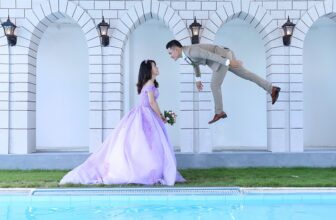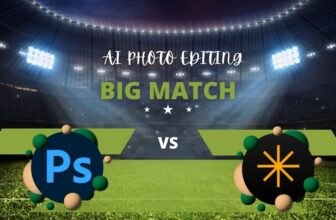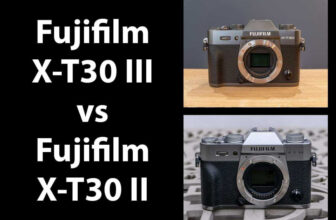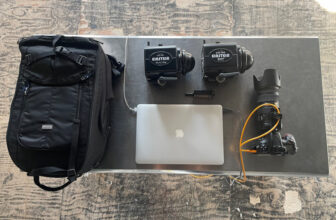
In our guide to the best lenses for studio photography, we’ll spotlight all you need to know to start and build your lens kit.
Knowing there is no “best lens” for studio work is essential. All studios are different, and there’s no one-size-fits-all type of studio work.
Plus, studios are controlled environments where you can better manage lighting and control the scene and exposures.
Our guide will help you select the best studio lens for your genre and the specific needs of your studio space.
Chances are, you already own at least one ideal lens for studio work. Let’s help you find some more.
Top 5 Lenses I Recommend for Studio Photography
As the introduction mentions, studio photography has no actual “best” lens. However, several lens types are best suited to studio photography.
Besides, the best lens is the one that you know, love, and have mastered to the point where you can confidently create the desired images without excessive editing.
It’s also important not to be fooled by the misconception that studio photography can only be shot with fast, wide-aperture primes. This is simply not true, and it deters many from attempting studio work.
Photographic studios offer an opportunity to gain greater control of exposure and composition through effective off-camera lighting solutions.
As a result, you don’t always need an f/1.2 prime lens to optimise exposure – the lighting takes care of that for you. With that in mind, let’s look at the types of lenses I recommend for studio work.
Tamron 35-150mm f/2-2.8 (Best All-Rounder for Products, Portraits, and Fashion)


- Flexible focus range
- Fast max aperture
- Sharp image outcomes
- Perfect for smaller studios
Tamron has been in the photographic optics business since 1950, founded as the Taisei Optical Manufacturing Company.
Since its inception, Tamron has proven to be a world-class lens developer, creating exceptional third-party alternatives for all popular lens mounts.
The Tamron 35-150mm f/2-2.8 Di III VXD is an excellent example of the brand’s efforts to produce fast, sharp lenses that deliver impressive image quality.
Tamron’s 35-105mm is an incredibly flexible lens that would serve beginner studio photographers as a ‘do-it-all’ lens.
The full-frame 35-105mm focal range delivers a diverse 63° to 16° field of view and a surprisingly close 13″ (33cm) minimal focus distance.
The Tamron supports an 82mm filter thread, measures 3.5 x 6.2″ (89.2 x 158mm), and weighs a considerable 2.6 lb (1165g)—although as a studio lens, you don’t have to carry it far.
A 35-105mm focal range is far more versatile than the classic 24-70mm f/2.8 and offers very few drawbacks.
Many people opt for the 24-70mm + 70-200mm lens combo, but this Tamron lens lets you do it all with just a single piece of glass. It covers the whole studio range in one sweep.


The 35mm wide end allows for work in smaller studios and for getting more of a scene into the frame. 85-100mm is an excellent range for portrait work in a small-medium studio where you can’t use a longer zoom.
Also, having a zoom centered on portrait-friendly 85mm is a huge help.
If you’re shooting with models, 90% of your shooting will likely occur between 50 and 110mm. That means you’d have to continually change lenses if you were working with the standard 24-70mm + 70-200mm lens combo.
Also, the Tamron offers a fantastically versatile range for APS-C (52.5-225mm). Be sure to read our full review of it here!
If you’re shooting Canon RF and don’t want to use the Tamron EF lens with an adaptor, the RF 24-105mm f/2.8 [Amazon | B&H] is a fantastic (though pricy) lens.
Nikon Z [Amazon | B&H] | | Nikon FX [Amazon] | Canon EF [Amazon] | Sony FE [Amazon | B&H]
85mm f/1.4 (Best Prime for Portraits)


- Perfect portrait prime
- Fast max aperture
- Gorgeous bokeh
- Fast focus performance
- Sony GM price tag
- Limited applications
If you shoot a lot of portraits and models in a studio, a fast 85mm full-frame (or APS-C equivalent) prime lens is an excellent addition to your growing studio lens kit.
Granted, I’ve said that fast apertures aren’t as critical in a studio, but for capturing close-up face shots, it makes a world of difference.
An 85mm f/1.4 is an ideal studio lens for portraits, headshots, products, and food photography.
Sony’s FE 85mm f/1.4 GM lens is a pro-grade prime with excellent compression, a 29° field of view, and a 2.62′ (80cm) minimum working distance. As a result, it’s still an excellent lens for smaller studio spaces.


The Sony 85mm f/1.4 delivers exceptional image sharpness and high-res detail. Thanks to an 11-bladed aperture diaphragm, subject separation, depth of field, and background blur are second to none.
However, the Sony is expensive and heavy at 1.8 lb (820g) – it’s a beast!
The Sigma 85mm f/1.4 Art lens is an excellent and affordable alternative. It’s available for Canon EF [Amazon | B&H], Nikon F [Amazon | B&H], Sony FE [Amazon | B&H], and Leica [Amazon | B&H].
Note that the Nikon Z only has an 85mm f/1.8 and an f/1.2. The f/1.8 is vastly more affordable and is in the links below.
Canon RF only offers the 85mm at f/2 and f/1.2. We’ve included the highly affordable f/2 in the links below (the f/1.2 is crazy expensive).
If you want to achieve the same field of view as an 85mm lens on a full-frame camera, you should look for a lens around 55-57mm for your APS-C camera.
Nikon Z [Amazon | B&H] | Nikon Z DX [Amazon | B&H] | Nikon FX [Amazon | B&H] | Canon EF [Amazon | B&H] | Canon APS-C [Amazon | B&H] | Canon EF-M [Amazon | B&H] | Canon RF [Amazon | B&H] | Canon RF APS-C [B&H] | Sony FE [Amazon | B&H] | Sony APS-C [Amazon | B&H] | Fujifilm [Amazon | B&H] | Micro Four-Thirds [Amazon | B&H]
70-200mm f/2.8 (Best Zoom for Portraits & Headshots)


- Flexible zoom range
- Creative portraiture
- Studio workhorse lens
- Optical image stabilisation
- Fast focus performance
- Big and heavy
- Expensive for beginners
Don’t let the “Sports” in the Sigma 70-200mm f/2.8 DG DN OS Sports lens fool you. It’s a cracker of a studio lens that produces sharp images and offers creative freedom.
Sigma’s 70-200mm f/2.8 has impressive specs, including a high-response linear actuator AF System and Optical Stabilizer with OS2 Algorithm.
While fast focus performance isn’t always needed in studio work, it doesn’t hurt. Besides, optical image stabilisation supports slower shutter speeds without compromising image sharpness.
The 70-200mm focal range makes this lens ideal for portraiture and products in a larger studio space.


With the ability to step back from your subject and capture a tighter compression, backgrounds are obliterated even with the constant f/2.8 max aperture.
Plus, it provides more perspective compression than the 85mm; also, some faces look better at 70mm, and some look better at 200mm. This lens will help you find the sweet spot.
The Sigma 70-200mm f/2.8 delivers a 34.3° to 12.3° field of view and supports a 25.6″ (65cm) minimum focal distance.
Sigma’s pro-grade zoom measures 3.6 x 8.1″ (90.6 x 207mm) and weighs 2.9 lb (1335g). It supports 77mm front-mount filters.
Given its size and weight, the 70-200mm also includes a removable collar for safely securing the lens and camera combo to a tripod.
While the Sigma is a pro-grade lens with a pro-grade price, the investment will optimise image outcomes and client satisfaction.
Nikon Z [Amazon | B&H] | Nikon FX [Amazon | B&H] | Canon EF [Amazon | B&H] | Canon RF [Amazon | B&H] | Sony FE [Amazon | B&H] | Fujifilm [Amazon | B&H] | Micro Four-Thirds [Amazon | B&H]
50mm f/1.8 (Best Budget Studio Lens for Portraits & Products)


- Excellent beginner lens
- Versatile prime for studio
- Natural field of view
- Highly affordable
- Good low-light outcomes
- Less flexible than a zoom
- Save up for a 1.4 or 1.2
It goes without saying that every studio photographer, regardless of their budget, needs a nifty-fifty.
Nifty-fifty refers to a 50mm full-frame prime lens (or APS-C equivalent). While the nifty bit refers to it being inexpensive and typically having a slower maximum aperture, you get the point.
A 50mm lens is considered the champion of prime lens focal distance options. With a 50mm lens in a studio, you can shoot portraits, products, food, and even fashion—provided you have the room to step back a bit.
As per the links below, every leading first and third-party brand develops a range of 50mm lenses. Some brands offer a suite of primes, including a 50mm f/1.2, 50mm f/1.4, and 50mm f/1.8.


50mm prime lenses with an f/1.8 or f/2 maximum aperture are versatile and super affordable.
Plus, a 50mm focal distance offers a natural perspective (47º field of view) and has good low-light performance, even at f/2.
Sony’s FE 50mm f/1.8 is a perfect example of a nifty-fifty that offers a relatively fast maximum aperture and a budget-friendly price tag.
If you’re starting as a studio photographer, you could do much worse than having this near-pocketable prime in your kit.
Speaking of which, the Sony FE 50mm f/1.8 measures ø: 2.7 x 2.34″ (68.6 x 59.5mm) and weighs just 6.56 oz (186g). As I said, it’s near pocketable!
When it comes to nifty-fifty primes, an f/1.8 is excellent and perfect for beginners, but an f/1.4 or f/1.2 will deliver greater depth of field and gorgeous background bokeh.
Nikon Z [Amazon | B&H] Nikon FX [Amazon | B&H] | Nikon DX [Amazon | B&H] | Canon EF [Amazon | B&H] | Canon APS-C [Amazon | B&H] | Canon RF [Amazon | B&H] | Sony FE [Amazon | B&H] | Sony APS-C [Amazon | B&H] | Fujifilm [Amazon | B&H] | Micro Four-Thirds [Amazon | B&H]
100mm f/2.8 / 105mm f/2.8 Macro (Best Lens for Small Products & Details)


- Product photography workhorse
- Exceptional image sharpness
- Highly affordable
- Best for jewellery
- Only for Sony E and Leica L
- Autofocus niggles
The Sigma 105mm f/2.8 DG DN Macro Art prime lens is a product photographer’s dream, especially if your product shots demand exceptional levels of intricate detail.
Being a macro lens, the 11.6″ (29.5cm) minimum focus distance and 1:1 macro reproduction ratio produce true-to-life detail even with small items like jewellery.
Sigma’s 105mm f/2.8 DG DN Macro Art prime produces a tight compression with a 23.3° field of view. We loved the lens in our full review.


The relatively fast f/2.8 maximum aperture ensures depth of field control and pleasing background blur.
It also makes for a cracker of a portrait lens, provided you’ve got a larger studio space where you can step back a bit.
The mid-size studio lens measures 2.9 x 5.3″ (74 x 135.6mm) and weighs a comfortable 1.6 lb (710g).
Given the affordability of the weather-sealed lens, it’s incredible that it also features a custom AFL button, focus limiter switch, and dedicated aperture ring with a de-click switch for silent operation.
It’s one of the best macro lenses for Sony E mount systems on the market!
For the big brands, the focal length depends on your brand and lens mount: 100mm for Canon EF/RF, 105mm for Nikon Z, etc.
Nikon Z [Amazon | B&H] | Nikon FX [Amazon | B&H] | Canon EF [Amazon | B&H] | Canon RF [Amazon | B&H] | Sony FE [Amazon | B&H]
How to Pick the Best Lenses for Your Particular Style of Studio Photography


Choosing the best lens for any photography project can be tricky. My first advice is to NOT rush to the camera store and take out a mortgage to get one of each lens type.
Lens choice factors include the size of your studio, the type of content you’re shooting, and your personal preferences (as well as focal length, aperture, and image quality).
Most professional studio photographers have a collection of lenses to have the right tool for each job. But that doesn’t mean you have to start that way.
Start slow and build.
Budget and Beginners
If you’re a beginner, on a budget, or you’ve just set up a small home studio and are looking to build your lens kit, there’s no rush.
Start with the 24-70mm full-frame equivalent kit lens you probably picked up when you first bought your camera. A 24-70mm with a constant f/2.8 or a f/2.8-4 max aperture is a flexible lens that can capture most genres in a studio.
At the wide 24mm end, you can capture dynamic fashion shots and much larger products such as home appliances, bicycles, and more.
At the 70mm end, you’ll build the skills to photograph portraits, headshots, food, and products.
Remember that an f/2.8 aperture still delivers subject separation and, with the proper lighting, non-distracting background blur.
Slower 24-70mm f/4 full-frame kit lenses start at around US$1,000, and the price increases the faster the aperture. APS-C options are often even cheaper.
Studio Space
The size of your studio space will also determine the lenses you’ll need for your kit.
There’s no point picking up the Sigma 70-200mm f/2.8 DG DN OS Sports lens if you can’t step back to frame a composition at the 200mm end of the range.
Before you click “add to cart,” consider the studio’s size and shape, available natural light, and off-camera lighting.
With the proper studio lighting from LEDs and strobes, you needn’t worry as much about features such as an ultra-fast max aperture or optical image stabilisation.
Work with 50mm and 85mm full-frame equivalent lenses if working in a smaller studio space.
Studio Genre
Studio spaces can be used to photograph everything from tiny products like jewellery to huge products like vehicles. The size of the space and the styles or genres of photography in the brief determine the possibilities.
If you’re set on photographing a specific genre that works within your available space, then it’s time to consider the best lenses for the job.
You’ll also need to consider the best off-camera lighting solutions to optimise exposure and compositional elements.
Once again, work with the lenses you already have available (such as a 24-70mm kit lens) and practice (x 1,000) to master the outcomes with that lens.
The next step is to review your images and pay close attention to the focal distance and aperture used to capture your best shots.
If you primarily work at 50mm, consider investing in a 50mm prime with a faster f/1.8 or f/1.4 aperture. If you wish you had a little more reach than 70mm, consider an 85mm full-frame focal distance.
Using this approach, you can slowly build your studio photography lens kit to suit your style and growing skillset.
FAQs about the Best Lenses for Studio Photography
What focal length is best for studio portraits?
The best focal length for studio portraits is 85mm (full-frame equivalent). At 85mm, the roughly 30º field of view delivers tight compression with sharp facial details and smooth background blur or bokeh.
Should I use a prime lens or a zoom lens when shooting studio photography?
If you desire a faster maximum aperture (f/1.2, f/1.4, f/1.8), use a prime lens in a studio. While zoom lenses offer greater flexibility, they typically have narrower maximum apertures.
Do I really need a fast lens if I’m shooting with strobes?
If you shoot in a studio with off-camera strobe lights, you don’t need a fast lens. However, if you shoot portraits and desire a shallow depth of field with gorgeous background bokeh, a faster f/1.2 aperture is recommended.
How important is image stabilization in studio photography?
Optical or lens-based image stabilization isn’t necessary in studio photography unless you plan to work with slow shutter speeds while shooting handheld.
What are the best camera settings for studio photography?
The best camera settings depend on many factors, including subject movement, studio lighting, desired depth of field, and which elements need to be in focus. There isn’t a one-size-fits-all approach, but learning the exposure triangle is a great place to start.
Credit : Source Post






